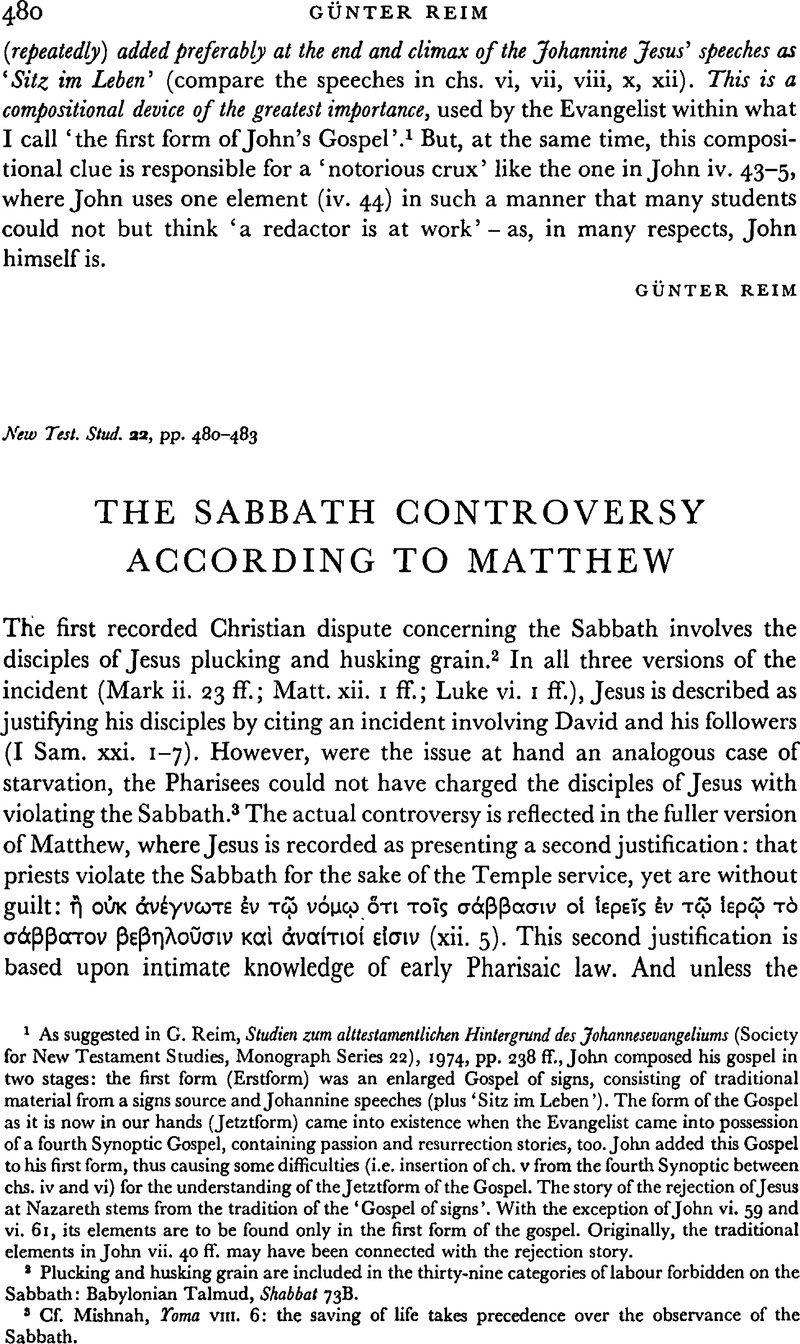Published online by Cambridge University Press: 05 February 2009

page 480 note 2 Plucking and husking grain are included in the thirty-nine categories of labour forbidden on the Sabbath: Talmud, Babylonian, Shabbat 73B.Google Scholar
page 480 note 3 Cf. Mishnah, , Yoma viii. 6Google Scholar: the saving of life takes precedence over the observance of the Sabbath.
page 481 note 1 Albright, W. F. and Mann, C. S., Matthew (New York (Anchor Bible), 1971), pp. 148 f.Google Scholar
page 481 note 2 See etymology in Brown, Francis, Driver, S. R. and Briggs, Charles A., A Hebrew and English Lexicon of the Old Testament (Oxford, 1907), p. 771Google Scholar. Compare later citations in Jastrow, Marcus, A Dictionary of the Targumim, the Talmud Babli and Yerushalmi, and the Midrashic Literature (New York, 1955), II, 1053.Google Scholar
page 481 note 3 Mishnah, , Menahot 65 AGoogle Scholar; cf. Talmud, Babylonian, Mo'ed Qatan 11 BGoogle Scholar and Tosafot, to Hagigah 18 AGoogle Scholar and 'Abodah Zarah 22 A.Google Scholar
page 481 note 4 See Mishnah, , Menahot x, 3, 10Google Scholar. When offered on the Sabbath, it was prepared by cutting three seah of barley sifted down to one 'omer: Mishnah, , Menahot x, IGoogle Scholar and Tosefta, , Demai 1, 28.Google Scholar
page 481 note 5 Talmud, Babylonian, Menahot 65 A.Google Scholar
page 482 note 1 Johnson, Sherman E., ‘Matthew’, Interpreter's Bible (New York, 1952), p. 392.Google Scholar
page 482 note 2 Num. xxviii. 9 et seq.; also see Mishnah, , Shabbat XVIII. 3.Google Scholar
page 482 note 3 Bowie, Walter Russell, ‘Luke’, Interpreter's Bible, pp. 110f.Google Scholar
page 482 note 4 Lampe, G. W. H., ‘Luke’, Peake's Commentary on the Bible, ed. Black, M. (London, 1962), p. 829.Google Scholar
page 482 note 5 (I.e., v. 62 οτı του ιερου ![]() έστıν ωδε.)
έστıν ωδε.)
page 482 note 6 Parenthetically, the cutting of the 'orner and its offering in the Temple had the effect of allowing the use of the new crop in the country ( Mishnah, , Menahot x. 6Google Scholar). Thus, Jesus is also challenging this prerogative of the Temple.
page 482 note 7 For MS evidence cf. Levine, Etan, The Aramaic Version of Ruth (Rome (Analecta Biblica), 1973), pp. 64 fGoogle Scholar. et ad loc.
page 483 note 1 See Rabbah, Midrash Ruth in. 6Google Scholar: ‘Rabbi Simeon said: That day was the cutting of the 'omer… all of the towns gathered together, that it might be reaped with great ceremony.’ Cf. op. cit. IV. 2.Google Scholar
page 483 note 2 For further contradictions of the Pharisaic-Rabbinic tradition, cf. Levine, Etan, op. cit., adGoogle ScholarRuth, i. 13Google Scholar, 17, 22, ii. 4, 7 and iv. 5ff.
page 483 note 3 Ginzberg, Louis, Legends of the Jews (Philadelphia, 1938), VI, 190Google Scholar, suggests amending the targum to read ‘at the termination of the first day of Passover’ (bemifaq yoma' a d'pasha'). This is no more convincing than the suggestion of Melamed, Ezra, ‘Le-targum Megillat Rut’, Annual of Bar-Ilan University (1965), p. 194Google Scholar that the targum has misunderstood the Mishnah ( Menahot x 3Google Scholar) providing the date for cutting the 'orner!
page 483 note 4 This identical method is employed by the targum in Ruth iv. 7, where it attributes to ‘all Israel’ a practice which diverges from Pharisaic-Rabbinic halakah.